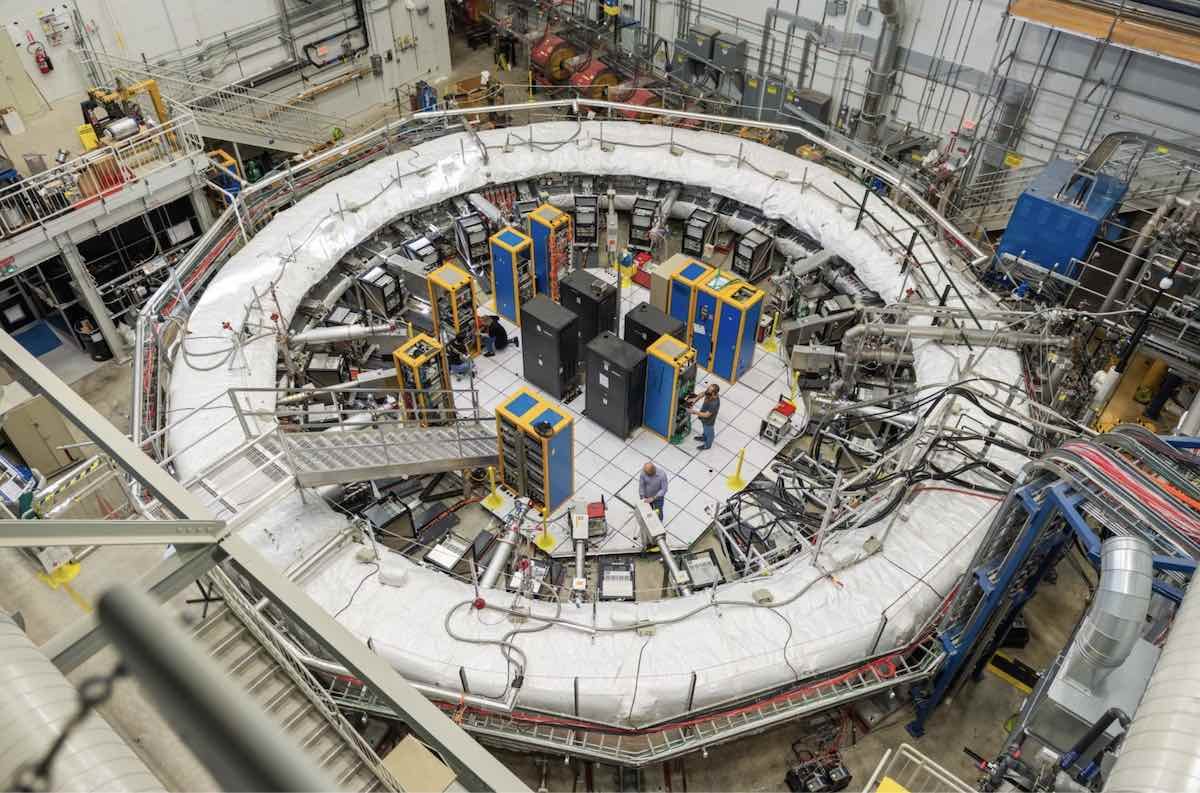Physicists at the U.S. Department of Energy’s Fermi National Accelerator Laboratory near Chicago say they are on the brink of confirming the existence of an unprecedented fifth force of nature.
If verified, the discovery of a new fifth force of nature would reshape our knowledge of subatomic physics and stand as one of the most significant scientific breakthroughs in the last 100 years.
The current understanding of the universe involves four fundamental forces of nature: gravity, electromagnetism, and strong and weak nuclear forces. These fundamental forces describe how everything in the universe interacts with each other under the theory known as the Standard Model.
The Standard Model has stood as an unyielding pillar in particle physics for over half a century. It accurately depicts how objects and particles in our universe interact. However, recent findings suggest we may be on the cusp of adding a fifth force of nature to the list.
Enigmatic sub-atomic particles known as muons are at the center of this burgeoning revelation. Structurally, muons are similar to electrons but 200 times heavier.
In 2021, Fermilab scientists discovered that when placed in powerful superconducting magnets, muons exhibited a motion that could not be predicted using the current Standard Model of physics. This discrepancy led to the initial tantalizing hypothesis that an unknown fifth force of nature might be at play.
In the initial discovery, physicists acknowledged there was a one in a 40,000 chance that the results were a statistical fluke, translating to a confidence level labeled as 4.1 sigma.
Since then, researchers say they have reduced the uncertainty of their measurements by a factor of two, increasing the precision of results and offering unprecedented insight into muon behavior.
“We’re really probing new territory. We’re determining the muon magnetic moment at a better precision than it has ever been seen before,” Brendan Casey, a senior scientist at Fermilab who has worked on the Muon g-2 experiment since 2008, said in a press release.
In an experiment dubbed “Muon g-2,” scientists sent muons racing around a nearly 50-foot diameter ring at near-light speeds almost 1,000 times.
Examining what has been described as the “world’s most precise measurement of the anomalous magnetic moment of the muon,” researchers found the same mysterious movement, which cannot be accounted for by the current theoretical framework for particle physics.
Announcing the results in a public live-stream seminar on August 10, the international team of scientists working on FerimiLab’s g-2 project says they are now “doubling down” on the previous hypothesis that muons’ bizarre behavior is being caused by an unknown fifth force of nature.
“We think there could be another force, something that we are not aware of now. It is something different, which we call the ‘fifth force,'” Dr. Graziano Venanzoni of Liverpool University, one of the project’s leading researchers, told BBC News. “It is something different, something we don’t know about yet, but it should be important because it says something new about the Universe.”
The Fermilab team had hoped for conclusive evidence by now, proving the results demonstrate a new fifth force of nature. However, developments in theoretical physics have increased uncertainties in what the Standard Model accounts for in the motion of muons.
Nevertheless, scientists say that the recent measurements exceeded the initial design goal of reducing the uncertainty caused by experimental imperfections, known as systematic uncertainties.
“This measurement is an incredible experimental achievement,” Peter Winter, co-spokesperson for the Muon g-2 collaboration, said in a press release. “Getting the systematic uncertainty down to this level is a big deal and is something we didn’t expect to achieve so soon.”
Offering some healthy scientific competition, researchers working at Europe’s Large Hadron Collider (LHC) are also diligently exploring muons in a race to confirm the existence of a new fifth force of nature.
Managed by the European Center for Nuclear Research, or CERN, outside Geneva, the LHC made headlines in 2012 when the nearly 17-mile underground particle accelerator confirmed the existence of the Higgs boson. This long-searched-for particle gives mass to all other particles in the universe.
At the end of 2018, the LHC was shut down for upgrades, eventually reopening in the summer of 2022. Now, back in business, physicists with CERN are hoping they, too, can shake up the Standard Model of particle physics.
“Measuring behavior that doesn’t agree with the predictions of the Standard Model is the holy grail for particle physics,” Dr. Mitesh Patel from Imperial College London and physicist working at the LHC told BBC News. “It would fire the starting gun for a revolution in our understanding because the model has withstood all experimental tests for more than 50 years.”
Proving the existence of a new fifth force of nature would represent one of the most significant scientific breakthroughs in over a century. Arguably, as monumental as Albert Einstein’s theories of relativity, it could help explain a multitude of observations in astrophysics or quantum physics, which currently reside outside the realm of the Standard Model.
The Muon g-2 team at Fermilab believes by 2025, they will have all the data they need to release their final, “most precise measurement of the muon magnetic moment” and potentially conclusive proof for a new fifth force of nature.
As Fermilab braces for its next set of results, the global scientific community stands at the cusp of possibly the most significant breakthrough in modern physics, as researchers say the countdown to the “ultimate showdown” between the Standard Model and experiment has begun.
Fermilab says the Muon g-2 team’s pioneering research and recent findings have been submitted to the Journal Physical Review Letters for publication.
Tim McMillan is a retired law enforcement executive, investigative reporter and co-founder of The Debrief. His writing typically focuses on defense, national security, the Intelligence Community and topics related to psychology. You can follow Tim on Twitter: @LtTimMcMillan. Tim can be reached by email: tim@thedebrief.org or through encrypted email: LtTimMcMillan@protonmail.com

